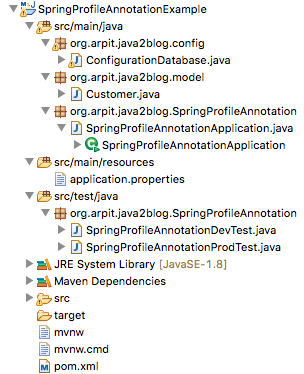Table of Contents
In this tutorial, we will see about Spring @Profile annotation. This tutorial is an extension to Spring boot profile example.
Profile annotation represents named logical grouping may be activated via
- By using
ConfigurableEnvironment.setActiveProfiles(java.lang.String...) - By setting the
spring.profiles.activeproperty as a JVM system property, as an environment variable, or as a Servlet context parameter in web.xml for web applications. - You can also use
@ActiveProfiles< while doing integration testing
The @Profile annotation may be used in any of the following ways:
- As a type-level annotation on any class directly or indirectly annotated with @Component, including @Configuration classes
- As a meta-annotation, for the reason of composing custom stereotype annotations
- It can be used method-level annotation on any @Bean annotation
Let’s see with the help of an example.
Step 1: Go to "https://start.spring.io/" and create spring boot projects as per below screenshot.

Step 2: Import the maven project in eclipse.
step 3: Create a package named "org.arpit.java2blog.model"
create a model class named "Customer.java"
|
1 2 3 4 5 6 7 8 9 10 11 12 13 14 15 16 17 18 19 20 21 22 23 24 25 26 27 28 29 30 31 32 33 34 35 36 |
package org.arpit.java2blog.model; public class Customer { int id; String name; String email; public Customer(int id, String name, String email) { super(); this.id = id; this.name = name; this.email = email; } public int getId() { return id; } public void setId(int id) { this.id = id; } public String getName() { return name; } public void setName(String name) { this.name = name; } public String getEmail() { return email; } public void setEmail(String email) { this.email = email; } } |
Step 4:Create a package named “org.arpit.java2blog.config”
create a config class named “ConfigurationDatabase.java”
|
1 2 3 4 5 6 7 8 9 10 11 12 13 14 15 16 17 18 19 20 21 22 23 24 25 26 27 |
package org.arpit.java2blog.config; import org.arpit.java2blog.model.Customer; import org.springframework.context.annotation.Bean; import org.springframework.context.annotation.Configuration; import org.springframework.context.annotation.Profile; @Configuration public class ConfigurationDatabase { @Profile("dev") @Bean(name="customer") public Customer getDevCustomer() { } @Profile("prod") @Bean(name="customer") public Customer getProdCustomer() { } } |
Step 5: Create test class named “SpringProfileAnnotationDevTest” in src/test/java.
|
1 2 3 4 5 6 7 8 9 10 11 12 13 14 15 16 17 18 19 20 21 22 23 24 25 26 27 28 29 30 31 32 33 34 35 36 |
package org.arpit.java2blog.SpringProfileAnnotation; import static org.junit.Assert.assertEquals; import static org.junit.Assert.assertNotNull; import org.arpit.java2blog.config.ConfigurationDatabase; import org.arpit.java2blog.model.Customer; import org.junit.Test; import org.junit.runner.RunWith; import org.springframework.beans.factory.annotation.Autowired; import org.springframework.boot.test.context.SpringBootTest; import org.springframework.context.ApplicationContext; import org.springframework.test.context.ActiveProfiles; import org.springframework.test.context.ContextConfiguration; import org.springframework.test.context.junit4.SpringRunner; import org.springframework.test.context.support.AnnotationConfigContextLoader; @RunWith(SpringRunner.class) @SpringBootTest @ActiveProfiles(value="dev") @ContextConfiguration(classes= {ConfigurationDatabase.class},loader=AnnotationConfigContextLoader.class) public class SpringProfileAnnotationDevTest { @Autowired private ApplicationContext applicationContext; @Test public void testDevDataSource() { Customer customer = (Customer)applicationContext.getBean("customer"); assertNotNull(customer); assertEquals("John", customer.getName()); } } |
Here
@SpringBootTest annotation is used to run Spring boot test.
@ContextConfiguration provides class-level metadata to determine how to load and configure an ApplicationContext for integration tests.
@ActiveProfiles is used to provide name of the profile which will be activated while running integration tests.
Step 6: Run the test
When you run above test, you will get below output:

Step 7:Create another test class named “SpringProfileAnnotationProdTest” in src/test/java.
create a class named “SpringBootHelloWorldApplication.java”
|
1 2 3 4 5 6 7 8 9 10 11 12 13 14 15 16 17 18 19 20 21 22 23 24 25 26 27 28 29 30 31 32 33 34 35 |
package org.arpit.java2blog.SpringProfileAnnotation; import static org.junit.Assert.assertEquals; import static org.junit.Assert.assertNotNull; import org.arpit.java2blog.config.ConfigurationDatabase; import org.arpit.java2blog.model.Customer; import org.junit.Test; import org.junit.runner.RunWith; import org.springframework.beans.factory.annotation.Autowired; import org.springframework.boot.test.context.SpringBootTest; import org.springframework.context.ApplicationContext; import org.springframework.test.context.ActiveProfiles; import org.springframework.test.context.ContextConfiguration; import org.springframework.test.context.junit4.SpringRunner; import org.springframework.test.context.support.AnnotationConfigContextLoader; @RunWith(SpringRunner.class) @SpringBootTest @ActiveProfiles(value="prod") @ContextConfiguration(classes= {ConfigurationDatabase.class},loader=AnnotationConfigContextLoader.class) public class SpringProfileAnnotationProdTest { @Autowired private ApplicationContext applicationContext; @Test public void testDevDataSource() { Customer customer = (Customer)applicationContext.getBean("customer"); assertNotNull(customer); assertEquals("Martin", customer.getName()); } } |
Step 8: Run the test
When you run above test, you will get below output:

As you can see, we are getting different bean based on active profile.
As we you can see we are getting name as “John” with @ActiveProfiles(value="dev") and “Martin in case of @ActiveProfiles(value="prod")
Project Structure

Source code
That’s all Spring profile annotation.


